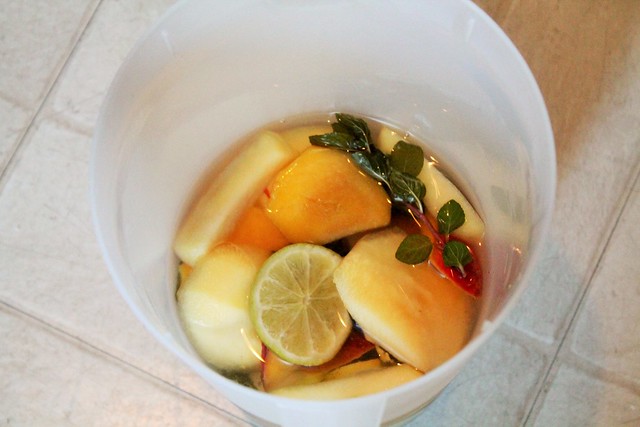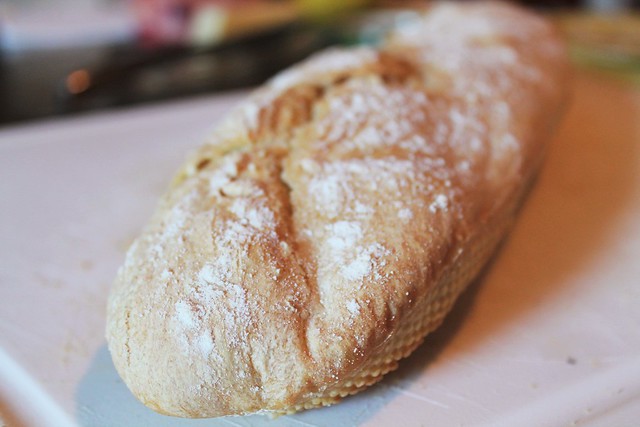This post has been a long time in the making...almost a month to be exact. Thank goodness I didn't let it get that far. This summer has been filled with baking, writing, job hunting, violin playing, but not a lot of blogging!
I'm sorry.
Almost, but not quite, a month ago my girl, Amy, came over one Saturday while Hubby was away. We spent a better part of the day making bread and drinking sangria.
It was pretty much the best day ever.
Amy brought the sangria and if you know anything about sangria you should know it is super easy to make and the most refreshing drink for a hot summer day. We experienced peach sangria while we were out to dinner a few days prior to our bread making palooza, so naturally Amy loaded hers with peach in addition to the ordinary apple, lime, and...wait for it...mint!
Isn't it the most colorfully beautiful fruitastic* thing you ever saw?
*Fruitastic: adj. A fruit explosion of awesomeness. Ex: The sangria Amy made was fruitastic and made my mouth happy.
She used two different kinds of mint. Regular and chocolate mint. Chocolate mint. I'm telling you, the world of herbs gets more awesome as each day passes.
After we seltzed our drinks with some Ginger Ale, we started into the dough.
Knowing that the dough takes a minimum of two hours to rise, I made the dough two hours before Amy came over.
For Christmas, Hubby bought me this incredible book: Artisan Bread in Five Minutes a Day. It seemed such a specific book for him to buy me, but apparently it was one my heart had been wanting forever. This book is not just a book of bread recipes. It is a guidebook to making bread a part of your daily life. It is so intense, it doesn't even touch on recipes until chapter five. Chapter five is the 'Master Recipe', which is the only recipe I've used so far. I figure I need to master the master before I can move on to the peasants (seriously, one of the chapters is 'peasant loaves').
Making the master recipe is extremely easy. It takes everything you know about making bread to a simplistic yet mind blowing level. Warm water, yeast, salt, and flour are mixed together until everything is wet. Kneading is not necessary! In fact, it is discouraged.
The dough rises for two to five hours and then it is ready to be turned into delicious bread.
The master recipe is enough dough for four one-pound loaves. It is developed in a way so that all you have to do is tear off a chunk of dough and make a loaf. Effortless. Hence the name, "Artisan Bread in Five Minutes a Day". It literally takes five minutes to prep a loaf for baking.
This book has taught me so much about how to make bread that I can't believe the loaves I'm making haven't come straight from Italian People's Bakery. (If you've never been, get your patootie over to one and try their bread. It's amazing.)
Corn meal is spread out on a pizza peel before the loaf is placed. The above loaf is still part of the master recipe. It is known as 'Boule' which is an artisan free-form loaf.
Again, there is no kneading involved. Here's how simple it is: dust the top of the dough with flour, grab a one-pound hunk of dough, "cloak" (shape) the dough into a loaf for less than 60 seconds, let the loaf rest on the pizza peel.
My favorite part is that most of the bread recipes involve steam. As the oven is preheating, there are two things that should be in place in the oven: 1. a baking stone (which the loaf will slide off the pizza peel onto) 2. a broiler tray (placed on a rack under the stone). After the 40 minute rising time (I know, that part is a practice in patience) the dough is jerked from off the pizza peel and onto the stone. I still have issues with this, but regardless of how sloppy my pizza peel to baking stone transition has been the bread has always come out delicious. As soon as the bread is on the stone, pour a cup of water into the broiler tray. This creates steam which in turn creates a crisp crust.
Just like the pros.
Also like the pros, there is a 'dust and slash' step that occurs right before the bread goes into the oven. The top of the loaf is 'dusted' with flour, and then with a serrated bread knife you make slashes across the top.
This is the happiness that is homemade bread.
We got a little too excited over our first loaf of bread and pretty much demolished it in under a half hour. That might have been okay if we were only making one loaf. But we had planned on making three.
Yes, three. Amy and I have always been over achievers.
Every recipe used the master recipe dough so that made the starting out process easy. Our next loaf was "Sun-dried Tomato and Parmesan Bread" and it tasted just as scrumptious as it sounds.
This was one of those recipes that I second guessed everything I was doing. Was the bread rolled out too thick? Was it too thin? Is that a proper rectangle? Was everything evenly spread out?
And guess what? None of that mattered. Right or wrong, it still would have come out as a delicious hunk of tomato, parmesan, and bread.
Like this. I totally meant to make it in an 'S' shape. That was, of course, thoughtfully planned out.
Yeah, okay.
This lovely 'S' shape occurred because I am pretty sure I rolled my dough out too thin. Then when I went to transfer the dough from the pizza peel to the stone, I had a bit of an issue. An issue that is near impossible to correct because it involves a stone that is 450 degrees.
In the end, it didn't matter. The bread was still warm, crisp and filled with a mixture of the richness of Parmesan and the wild flavor of sun-dried tomatoes. I think this was Amy's favorite. Especially considering she texted me a few days ago a picture of a loaf of it that she made on her own at home.
As if we needed more bread at this point, we pressed on to make a 'Crusty White Sandwich Loaf". This was mainly to satisfy finally using my Italian and French bread loaf pans that I got for Christmas.
Though I loved, really loved, the Sun-dried Tomato and Parmesan bread, after this last loaf I don't think I could pick a favorite. The Crusty White Sandwich Loaf is exactly what you get when you buy stick bread from your local supermarket's bakery section. Except, of course, it's better.
See the little bumps? Don't they make it look authentic?
That's the glory of the Italian loaf pan.
See the little breakage at the top of the loaf?
That's the idiocy of someone who will remain nameless (hint, it wasn't Amy) putting too much dough on the pan. By the time the dough had risen, it was lopped over the side of the pan. I did my best to stretch it out, but that beautiful wrinkle still happened.
Let's just say it gives the bread character.
If you love baking and if you love bread, this method is for you. If you love baking but you don't love bread, please seek bread therapy. If you love bread but don't love baking, buy this book for someone you love who likes to bake. Then they will bake the most delicious breads ever, and hopefully, share them with you. I guarantee, the discovery of how easy it is to make artisan bread at home is something that no one can keep to themselves.














No comments:
Post a Comment